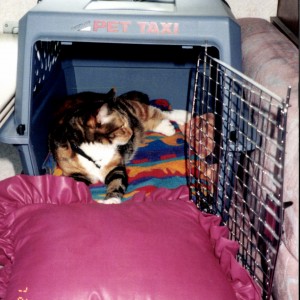Cat and crates seems to be a subject most people want to avoid. Does your cat hate going into a carrier or crate? Do you face a terrifying battle each time you face a trip to the vet? It doesn’t have to be that way. I can’t say all of my cats love car rides or crates, but most of them tolerate it quite well.

Let’s start with the primary reasons cats and crates are enemies. Usually, it’s because you only bring out the crate when it’s time for the annual vet visit, or the cat is not feeling well–another trip to be poked and prodded by strangers. You unintentionally trained the cat to expect the worst from being put into this strange little house. The problem can be undone with a little work on your part.
First of all, don’t hide it away. Bring it out and make it comfortable, like Pansy in the photo. We just use a small bungee cord to keep the door open. If the enclosure is too much, take the top and door off in the beginning. Then, eventually, add the top and door back on after it’s become a safe place, and let the kitty adapt to it that way too.
For some cats, being fed in the open crate works well to make it a more acceptable place. Kitties that are foodies usually go for this routine. Other enticements are toys, catnip, and feliway spray to send off comfort pheromones.
Don’t close the door or do anything scary at this point. Cats are slow to trust. After a two to four weeks, you can move on to starting to close the door. Put the food, toy, or a treat, in the crate and shut the door briefly while you are right there. Talk nicely like it’s all a game and then, open the door right away. Do that once or twice a day until the cat seems unconcerned. Then, start leaving the door closed a bit longer–not more than a few minutes at a time. If kitty starts crying, you left it too long. Gradually, extend the time to get up to a half hour to an hour. Reward your cat with lots of pets and nice talk.
Anytime, the change to a new step isn’t a success, don’t yell or scold, just release the cat without comment and ignore him/her for a while. Attention will provide reinforcement for the unwanted behaviors. Next time, go back to the last step.
The next post will address helping your cat adjust to travel. Whether it’s a vet trip, vacation, or visit to grandma, most cats have to travel at some time.
P.S. If you are just picking out a crate, we prefer to have it large enough to allow room for a small litter pan. We also like the type that screw together. Those are the safest in our experience. No zippers to break or plastic clips or hinges to give way at the wrong time. No one wants to endure losing a cat in a parking lot or airport. It’s worth a few extra dollars to get a good crate that’s large enough for all of your needs. More about all of this when we talk about travel.
